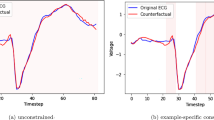Abstract
Counterfactual explanations can provide sample-based explanations of features required to modify from the original sample to change the classification result from an undesired state to a desired state; hence it provides interpretability of the model. Previous work of LatentCF presents an algorithm for image data that employs auto-encoder models to directly transform original samples into counterfactuals in a latent space representation. In our paper, we adapt the approach to time series classification and propose an improved algorithm named LatentCF++ which introduces additional constraints in the counterfactual generation process. We conduct an extensive experiment on a total of 40 datasets from the UCR archive, comparing to current state-of-the-art methods. Based on our evaluation metrics, we show that the LatentCF++ framework can with high probability generate valid counterfactuals and achieve comparable explanations to current state-of-the-art. Our proposed approach can also generate counterfactuals that are considerably closer to the decision boundary in terms of margin difference.
Access this chapter
Tax calculation will be finalised at checkout
Purchases are for personal use only
Similar content being viewed by others
Notes
- 1.
- 2.
- 3.
The full result table is available at our supporting website.
- 4.
References
Ates, E., Aksar, B., Leung, V.J., Coskun, A.K.: Counterfactual Explanations for Machine Learning on Multivariate Time Series Data. arXiv:2008.10781 [cs, stat] (August 2020)
Bagnall, A., Lines, J., Bostrom, A., Large, J., Keogh, E.: The great time series classification bake off: a review and experimental evaluation of recent algorithmic advances. Data Min. Knowl. Disc. 31(3), 606–660 (2016)
Balasubramanian, R., Sharpe, S., Barr, B., Wittenbach, J., Bruss, C.B.: Latent-CF: a simple baseline for Reverse Counterfactual Explanations. In: NeurIPS 2020 Workshop on Fair AI in Finance (December 2020)
Dau, H.A., et al.: Hexagon-ML: The ucr time series classification archive (October 2018). https://www.cs.ucr.edu/~eamonn/time_series_data_2018/
Dempster, A., Petitjean, F., Webb, G.I.: ROCKET: exceptionally fast and accurate time series classification using random convolutional kernels. Data Min. Knowl. Disc. 34(5), 1454–1495 (2020)
Ismail Fawaz, H., Forestier, G., Weber, J., Idoumghar, L., Muller, P.-A.: Deep learning for time series classification: a review. Data Min. Knowl. Disc. 33(4), 917–963 (2019)
smail Fawaz, H., et al.: InceptionTime: finding AlexNet for time series classification. Data Min. Knowl. Disc. 34(6), 1936–1962 (2020)
Joshi, S., Koyejo, O., Vijitbenjaronk, W., Kim, B., Ghosh, J.: Towards Realistic Individual Recourse and Actionable Explanations in Black-Box Decision Making Systems. arXiv: 1907.09615 (July 2019)
Kampouraki, A., Manis, G., Nikou, C.: Heartbeat time series classification with support vector machines. IEEE Trans. Inf Technol. Biomed. 13(4), 512–518 (2009)
Karlsson, I., Papapetrou, P., Boström, H.: Generalized random shapelet forests. Data Min. Knowl. Disc. 30(5), 1053–1085 (2016)
Karlsson, I., Rebane, J., Papapetrou, P., Gionis, A.: Locally and globally explainable time series tweaking. Knowl. Inf. Syst. 62(5), 1671–1700 (2019)
Kingma, D.P., Ba, J.: Adam: a method for stochastic optimization. In: Proceedings of the 3rd International Conference on Learning Representations (ICLR 2015) (January 2015)
Molnar, C.: Interpretable Machine Learning - A Guide for Making Black Box Models Explainable (2019)
Mothilal, R.K., Sharma, A., Tan, C.: Explaining machine learning classifiers through diverse counterfactual explanations. In: Proceedings of the 2020 Conference on Fairness, Accountability, and Transparency, pp. 607–617 (January 2020)
Pawelczyk, M., Haug, J., Broelemann, K., Kasneci, G.: Learning model-agnostic counterfactual explanations for tabular data. In: Proceedings of The Web Conference, vol. 2020, pp. 3126–3132 (2020)
Rebbapragada, U., Protopapas, P., Brodley, C.E., Alcock, C.: Finding anomalous periodic time series. Mach. Learn 74(3), 281–313 (2009)
Stepin, I., Alonso, J.M., Catala, A., Pereira-Fariña, M.: A survey of contrastive and counterfactual explanation generation methods for explainable artificial intelligence. IEEE Access 9, 11974–12001 (2021)
Wachter, S., Mittelstadt, B., Russell, C.: Counterfactual explanations without opening the black box: automated decisions and the GDPR. SSRN Electron. J. (2017)
Yao, S., Hu, S., Zhao, Y., Zhang, A., Abdelzaher, T.: DeepSense: a unified Deep Learning Framework for Time-Series Mobile Sensing Data Processing. In: Proceedings of the 26th International Conference on World Wide Web. pp. 351–360 (April 2017)
Acknowledgments
This work was supported by the EXTREMUM collaborative project (https://datascience.dsv.su.se/projects/extremum.html) funded by Digital Futures.
Author information
Authors and Affiliations
Corresponding author
Editor information
Editors and Affiliations
Rights and permissions
Copyright information
© 2021 Springer Nature Switzerland AG
About this paper
Cite this paper
Wang, Z., Samsten, I., Mochaourab, R., Papapetrou, P. (2021). Learning Time Series Counterfactuals via Latent Space Representations. In: Soares, C., Torgo, L. (eds) Discovery Science. DS 2021. Lecture Notes in Computer Science(), vol 12986. Springer, Cham. https://doi.org/10.1007/978-3-030-88942-5_29
Download citation
DOI: https://doi.org/10.1007/978-3-030-88942-5_29
Published:
Publisher Name: Springer, Cham
Print ISBN: 978-3-030-88941-8
Online ISBN: 978-3-030-88942-5
eBook Packages: Computer ScienceComputer Science (R0)



